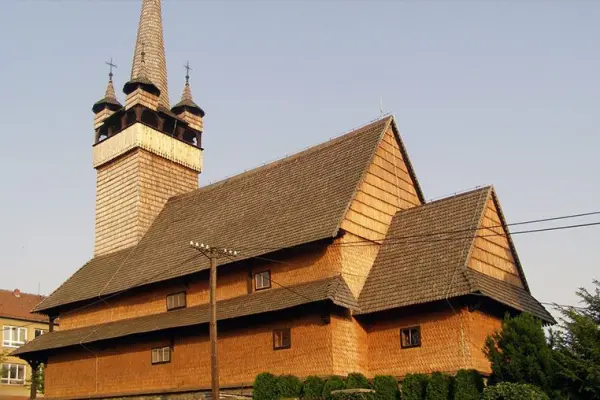While traveling through the Czech lands, it's impossible not to notice Ukrainian architectural landmarks. These neatly crafted wooden structures are mostly located on natural hills and impress with their refined carvings and perfectly proportioned domes and bell towers. These are monuments of Ukrainian vernacular sacred architecture in the Czech Republic, listed in the national registry and protected by the state. Among them are unique houses built using timber frame construction techniques that reflect the rich cultural heritage of the Ukrainian people. These buildings showcase not only the craftsmanship of ancient builders but also the practicality of traditional roofing solutions that have protected Ukrainian homes from the elements for centuries.
"Ukrainian wooden architecture is a unique phenomenon that combines structural practicality with high artistic value. These historic buildings serve as a living reminder of the deep cultural ties between nations and their shared Slavic heritage."
In 1919, when Zakarpattia became part of the new Czechoslovak Republic, Czech specialists were the first to take note of the beauty of Ukrainian folk wooden architecture in the Zakarpattia region. Thanks to decades of efforts by Czech patrons, writers, and scholars, five churches from different corners of Zakarpattia were relocated to the Czech Republic, significantly enriching the architectural styles represented in the country.
The oldest monument of Ukrainian architecture on Czech soil is the Church of St. Paraskeva in the town of Blansko in southern Moravia. This Orthodox church was built in 1601. The Ukrainian church was intended to adorn the Exhibition of Modern Culture in Brno in 1928. However, funds for its purchase and transportation were allocated by the Czechoslovak Ministry of Education only in 1936. Archival records show that a talented carpenter from Zakarpattia, Mykhailo Saleychuk, helped assemble the disassembled church from its parts. Today, the church serves the Czechoslovak Hussite Church and is a vivid example of Ukrainian cultural influence on the architectural landscape of the Czech Republic.
While studying the historical links between Ukrainian and Czech architecture, it's worth examining the various architectural styles found in both countries.
| Architectural style | Period of influence | Characteristic features | Examples in the Czech Republic |
|---|---|---|---|
| Wooden sacred architecture | 16th–19th centuries | Multi-tiered structures, tented roofs, wood carving | Church of St. Paraskeva in Blansko |
| Timber frame construction | 17th–20th centuries | Wooden framework filled with clay or brick | Traditional houses in ethnographic museums |
| Baroque | 17th–18th centuries | Ornateness, decorative richness, complex domes | Interior elements of relocated churches |
| Vernacular architecture | 16th–20th centuries | Use of local materials, functional design | Open-air museum displays |
This table illustrates the diversity of architectural styles found in Ukrainian buildings preserved in the Czech Republic. Each of these styles reflects a particular historical period of interaction and has contributed to shaping a unique cultural heritage.
The uniqueness of Ukrainian wooden churches also draws the attention of Martin Štěpán, a Czech researcher of Ukrainian folk architecture and staff member of the regional museum in Vysoké Mýto. "What makes them unique is that we are dealing with structures that were completely dismantled at their original locations, transported to a new site, and then reassembled," he says. Thanks to their relocation to the Czech Republic, these sacred buildings were preserved. Some of their original interiors, adorned with beautiful iconostases, have partially survived to this day, which is of special value to researchers of Slavic heritage.
"The preservation of Ukrainian architectural monuments in the Czech Republic is not just a matter of protecting historical buildings, but also of maintaining a living tradition that connects generations. In every carved element, in every dome’s proportion, lies the wisdom of our ancestors, which we are obliged to pass on to future generations."
The history of preserving the church from Medvedivtsi
In 1929, the Church of St. Michael from the Zakarpattian village of Medvedivtsi, built in the 18th century, was under threat of demolition. The local authorities planned to replace it with a stone structure. Czech ethnographer Florian Zapletal, who studied the folk architecture of Zakarpattia, learned about this and organized a campaign to save the monument. With the support of the Ministry of Education of Czechoslovakia, the church was purchased, dismantled, and transported to the town of Kunčice pod Ondřejníkem. Transporting 15 wagons with wooden parts of the church across the Carpathians was a true engineering feat. During the assembly, builders found that some elements were damaged and had to find craftsmen skilled in ancient wood-processing techniques. Today, this church is one of the most visited tourist attractions in the region.
The influence of Ukrainian architecture on modern Czechia
After the war in Ukraine began in 2022, many Ukrainian architects found work in Czechia. Their experience and professional expertise enrich modern Czech architecture with new ideas and approaches. Historical examples of outstanding figures, such as Ukrainian architects of the 20th century who created monumental buildings and shaped architectural schools, continue to inspire today's professionals. This cultural exchange maintains the historic tradition of mutual influence between the two Slavic countries in the field of architecture and construction.
"Architecture is a language through which nations speak across centuries. Ukrainian architectural monuments in Czechia are a cultural dialogue that began centuries ago and continues today. Anyone interested in historic buildings and cultural heritage will find inspiration and deep respect for the craftsmanship of ancient builders in these monuments."
Czech universities offer high-quality education in architecture, which attracts students from Ukraine. Graduates of such programs have the opportunity to work in Czech architectural firms, applying their knowledge and skills, which contributes to the preservation and development of the Ukrainian diaspora in the Czech Republic.

